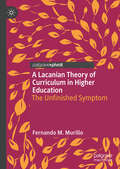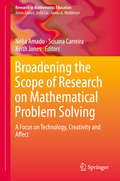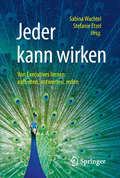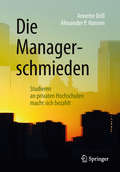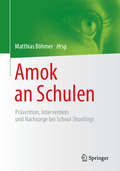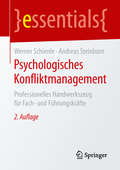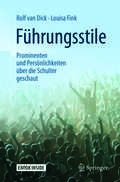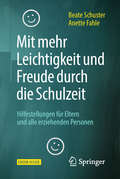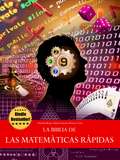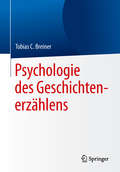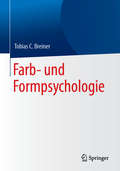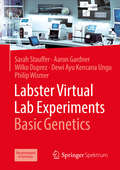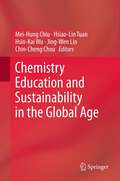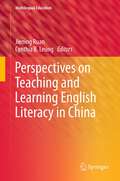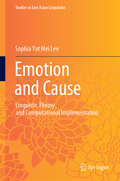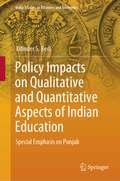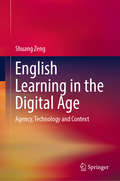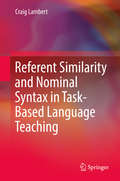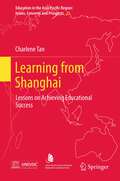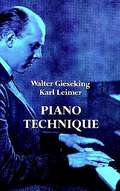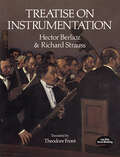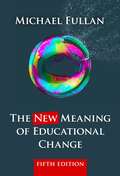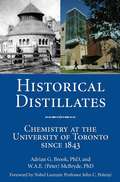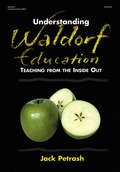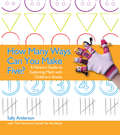- Table View
- List View
A Lacanian Theory of Curriculum in Higher Education: The Unfinished Symptom
by Fernando M. MurilloThis volume presents a distinctively Lacanian psychoanalytic approach to the theorizing, understanding, and critique of curriculum in higher education. In this work, the author presents the main theories of curriculum in the current discourse, develops a notion of critique, and applies it to existing global guidelines for curriculum reform. Relying on the architectonic of the subject as developed across the work of Jacques Lacan—expressed in the registers of the Symbolic, the Imaginary, and the Real—the author provides a new approach to understanding curriculum in terms of the psychic dynamics that explain its workings.
Broadening the Scope of Research on Mathematical Problem Solving: A Focus on Technology, Creativity and Affect (Research in Mathematics Education)
by Nélia Amado Susana Carreira Keith JonesThe innovative volume seeks to broaden the scope of research on mathematical problem solving in different educational environments. It brings together contributions not only from leading researchers, but also highlights collaborations with younger researchers to broadly explore mathematical problem-solving across many fields: mathematics education, psychology of education, technology education, mathematics popularization, and more. The volume’s three major themes—technology, creativity, and affect—represent key issues that are crucially embedded in the activity of problem solving in mathematics teaching and learning, both within the school setting and beyond the school. Through the book’s new pedagogical perspectives on these themes, it advances the field of research towards a more comprehensive approach on mathematical problem solving. Broadening the Scope of Research on Mathematical Problem Solving will prove to be a valuable resource for researchers and teachers interested in mathematical problem solving, as well as researchers and teachers interested in technology, creativity, and affect.
Jeder kann wirken: Von Executives lernen: auftreten, antworten, reden
by Sabina Wachtel Stefanie Etzel Kerstin KöhlerErfahren Sie, warum und wie Spitzenmanager und Politiker in Gespräch und Vortrag so gut wirken und sich in Diskussionen immer wieder durchsetzen. In diesem Buch verraten Autoren, die als Experten mit den Auftritten exponierter Personen in Wirtschaft, Politik und Gesellschaft zu tun haben, wie diese sich darauf vorbereiten bzw. vorbereitet werden und was weniger Prominente für ihr Auftreten auf der Bühne des Lebens davon nutzen können. Ob beim ersten Date oder einem Job-Interview, der Dinnerspeech zur Hochzeit des besten Freundes oder einer Präsentation vor dem Vorstand: Wenn es darauf ankommt, will man die beste Wirkung entfalten. Das lässt sich von den Profis lernen: gut auftreten, antworten, reden und einfach besser 'rüberkommen – Executive Communication für alle.
Die Managerschmieden: Studieren an privaten Hochschulen macht sich bezahlt
by Annette Doll Alexander P. Hansen10 Erfolgstipps für die richtige Studienwahl! Das Buch erläutert die Vorteile eines Studiums an einer deutschen, privaten Hochschule und erklärt, warum „Education Made in Germany“ ein international hochwertiges Produkt ist. Die Autoren zeigen konkrete Strategien, um die Studienorganisation erfolgreich zu gestalten, sodass Zeit und Geld sich auszahlen und auch der Spaß am Studium nicht zu kurz kommt. Mithilfe ihrer internationalen Expertise und anhand zahlreicher realer Erfolgsbeispiele deutscher sowie ausländischer Absolventen geben die Autoren dieses Ratgebers 10 Erfolgsgeheimnisse preis, die dabei helfen, das passende Studium an der richtigen Hochschule zu wählen und den Grundstein für ein erfülltes Berufsleben zu legen.
Amok an Schulen: Prävention, Intervention und Nachsorge bei School Shootings
by Matthias BöhmerSchool Shootings - umgangssprachlich auch als Amokläufe an Schulen bezeichnet - stellen eine seltene, aber schwerwiegende Form von zielgerichteter Gewalt an Schulen dar. Dieses Buch stellt erstens die in der aktuellen wissenschaflichen Forschung diskutierten Ursachen dar. Neben Tätermerkmalen wird auf das private wie schulische Lebensumfeld , den Einfluss von Massenmedien, die Zugänglichkeit zu Waffen sowie auf den Konsum gewalthaltiger Medien abgehoben. Zweitens werden primär- und sekundärpräventive Maßnahmen dargestellt wie das Profiling, Threat Assessments sowie das Phänomen des Leakings. Und drittens liegt der Fokus auf der Nachsorge bei School Shootings, deren Ziel es ist, erlebte psychotraumatische Belastung zu bewältigen. Es werden notfallpsychologische Akuthilfen, kurzfristige bis mittelfristige, traumafokussierte, sowie längerfristige Interventionsmassnahmen für Kinder, Jugendliche und Erwachsene näher erläutert. Praxisexkurse zur Prävention als auch zur Nachsorge ergänzen die entsprechenden Kapitel.
Psychologisches Konfliktmanagement: Professionelles Handwerkszeug für Fach- und Führungskräfte (essentials)
by Werner Schienle Andreas SteinbornSie wollen mit Konflikten (noch) besser umgehen können? Sie möchten wissen, wie Sie Ihre Interessen umsetzen, ohne dabei Scherbenhaufen in Ihren Beziehungen zu Kollegen, Vorgesetzten, Mitarbeitern oder auch im Bekannten- und Freundeskreis zu hinterlassen? Hier erfahren Sie es. In dieser zweiten Auflage des essentials, welches sich gleich in der ersten Auflage als Standardwerk etabliert hat, finden Sie nicht nur jede Menge handfester und leicht im Alltag einsetzbarer Tools, sondern Sie gewinnen auch wertvolle Einblicke in konfliktfördernde menschliche Denk- und Wahrnehmungsprozesse, deren Berücksichtigung Ihr Leben um vieles einfacher macht. Weniger Kleinkriege, dafür mehr Zeit und Energie für Ihre eigentlichen Tätigkeiten.
Führungsstile: Prominenten und Persönlichkeiten über die Schulter geschaut
by Rolf Van Dick Louisa FinkIn einer Zeit, die von Wandel und Veränderung geprägt ist, ist gute Führung entscheidend für den Erfolg – von Unternehmen, aber auch in der Politik oder im Sport. Aber wie sieht gute Führung aus?Der Leser bekommt mit diesem Buch exklusive Einblicke in die Praxis der Führung – nicht nur in Unternehmen, sondern in viele gesellschaftliche Bereiche: Von Kirche und Kunst über Journalismus und Militär bis zur Politik. Rolf van Dick hat mit herausragenden Menschen gesprochen, die in ihren Bereichen zu anerkannten Führungspersönlichkeiten zählen. Dazu gehören der Dalai Lama, Sara Wagenknecht, Birgit Prinz, Wolfgang Niedecken oder Günter Grass oder der ehemalige Bundespräsident Roman Herzog. Im Gespräch ist er diesen Persönlichkeiten – oft in ihrem Zuhause – nahe gekommen und hat faszinierende Geschichten gehört. Dieses Buch bietet eine inspirierende Auswahl der spannendsten Gespräche, in denen immer der Frage nach den ganz persönlichen Führungsstilen der Interviewpartner nachgegangen wird. Von der provokanten Frage angefangen, ob Führung überhaupt notwendig ist, diskutiert Rolf van Dick mit seinen Gesprächspartnern, warum Führung häufig schief geht, worauf es im 21. Jahrhundert ankommt und welche Werte für den Erfolg Aktualität haben. Auch die Frage, ob man Führung lernen kann oder dafür „geboren“ sein muss, wird sehr vielfältig beantwortet.Das Werk liefert Einsichten und bietet Anregungen sowohl für erfahrene Manager, als auch an Führung interessierten Einsteigern die eine Inspiration für ihren (Führungs-)Alltag suchen.
Mit mehr Leichtigkeit und Freude durch die Schulzeit: Hilfestellungen für Eltern und alle erziehenden Personen
by Beate Schuster Anette Fahle Claudia StyrskySchule heute bedeutet häufig Stress, Prüfungsangst, Antriebslosigkeit, Schwierigkeiten mit Stoff und Mitschülern, und zuhause Konflikte und Frust. Wie können Eltern helfen? Dieses Buch bietet erziehenden Personen, die einerseits solche schulische Probleme abfedern und andererseits nicht unabsichtlich durch eigenes Verhalten mitverursachen oder verstärken wollen, eine fundierte und lebenspraktische Hilfestellung. Eltern und erziehende Personen erfahren in diesem Buch anhand vieler praktischer Beispiele, wie sie selbst ganz konkret besser mit Verhaltensproblemen umgehen können und wie man im Alltag eine Kombination von Lenkung und Beziehung umsetzen kann. Das Buch gibt hilfreiche Hinweise und zeigt auf, was man bei motivationalen und emotionalen Problemen beachten und tun kann. Ferner gibt es Tipps für neue Strategien, die das Lernen erleichtern und zum erfolgreichen Umgang bei sozialen Schwierigkeiten mit Mitschülern und Mitschülerinnen und Lehrkräften. Ergänzend werden Übungen und Techniken aus der psychotherapeutischen Arbeit mit Kindern und Jugendlichen vorgestellt. Am Beispiel typischer Fälle werden die Überlegungen des Buches nochmal rekapituliert und illustriert. Die Bandbreite reicht von sozial ängstlichen bis zu ADHS-Schülern. … damit die Schulzeit wieder zur „schönsten Zeit des Lebens“ werden kann!
La Biblia de las Matemáticas Rápidas
by Danilo Lapegna Manuel Antonio Monroy Correa Yamada Takumi¿Qué tal un libro que te explique cómo las matemáticas pueden darte interminables herramientas estratégicas para permitirte ahorrar más dinero, hacer mejor y mejor tu trabajo, mejorar tus estudios, regresar a estar en forma y estar siempre en tu mejor momento? ¿Qué tal un libro que te pueda mostrar cómo hacer que el destino esté de tu lado en juegos de apuesta como el Póquer y el Veintiuno, con tan sólo un par de sumas mentales? ¿Qué tal un libro que pueda enseñarte fácilmente cómo sumar, dividir, multiplicar aún entre números de 5 cifras en 10 segundos? Bueno, ¿qué tal echándole un vistazo a "La Biblia de las Matemáticas Rápidas"? Directamente de las investigaciones de años de dos ingenieros de software, un libro revolucionario que te enseñará las matemáticas desde un puntno de vista completamente nuevo. Rápidamente aprenderás a cómo realizar cálclos extremadamente complejos en unos cuantos segundos; adquirirás valiosas competencias clave para el mundo académico y de negocios y, verás cómo muchas preciadas herramientas de estrategia para la vida diaria pueden construirse simplemente con las matemáticas que aprendiste en la escuela. ¡Teoría del juego, teoría de la probabilidad, matemáticas védicas, estrategias de guerra, culturas antiguas y estudios modernos se entretejen en un volumen que difícilmente olvidarás y siempre querrás conservar en tu biblioteca!
Psychologie des Geschichtenerzählens
by Tobias C. BreinerIn diesem Buch geht es um die Psychologie guter Geschichten und deren Handlungsfiguren. Es beantwortet Fragen wie:Warum rühren uns manche Filme zu Tränen und andere lassen uns kalt?Warum fesseln uns manche Romane so, dass wir bis tief in die Nacht weiterlesen? Warum quälen wir uns dagegen durch manche Pflichtlektüre hindurch?Warum zocken wir manches Adventure-Game bis zum letzten Level während wir bei anderen schnell die Lust verlieren? Das Werk ist für all diejenigen verfasst, die sich in irgendeiner Weise mit der Erzeugung und Bewertung von Handlungen befassen. Sowohl Charakter- und Game-Designer profitieren durch neue archetypische Modelle und Psychologen können mit der hier präsentierten dodekazyklischen Heldenreise innovative therapeutische Methoden entwickeln. Roman- und Drehbuchautoren bekommen eine Blaupause für erfolgsversprechende Geschichten, die sich auch auf das Interactive Storytelling übertragen lässt und Regisseure sowie Film-, Computerspiel- und Literaturkritiker erhalten durch den Inhalt des Werkes gezielte Bewertungskriterien.
Farb- und Formpsychologie
by Tobias C. BreinerDieses Werk ist eine umfassende und praxisrelevante Darstellung zur Farb- und Formpsychologie. Mit einer klaren Sprache und über 100 farbigen Abbildungen wird Ihnen die komplexe Thematik auf eine wissenschaftliche und anregende Art veranschaulicht.Über eine allgemeine Einführung in die Grundlagen des visuellen Systems hinaus werden Sie ebenfalls spezielles Wissen zu Assoziationen, Wirkungen und Anwendungen bestimmter Farben und Formen erwerben. Speziellen Wert legt der Autor dabei auf deren Einsatz im Game Design. Es wird zudem erstmals eine neue Farbstudie präsentiert, die zeigt, dass die Assoziationen zu Farben sich in einem in sich logischen dreidimensionalen System anordnen lassen. Die daraus gezogenen überraschenden Erkenntnisse liefern mögliche Antworten auf fundamentale Fragen der Philosophie. Das Buch ist daher nicht nur ein Muss für Wahrnehmungspsychologen und Designer, sondern eine Bereicherung für alle an dieser Thematik Interessierten.
Labster Virtual Lab Experiments: Basic Genetics
by Sarah Stauffer Aaron Gardner Wilko Duprez Dewi Ayu Ungu Philip WismerThis textbook helps you to prepare for both your next exams and practical courses by combining theory with virtual lab simulations. With the “Labster Virtual Lab Experiments” book series you have the unique opportunity to apply your newly acquired knowledge in an interactive learning game that simulates common laboratory experiments. Try out different techniques and work with machines that you otherwise wouldn’t have access to.In this volume on “Basic Genetics” you will learn how to work in a laboratory with genetic background and the fundamental theoretical concepts of the following topics:Mendelian InheritancePolymerase Chain ReactionAnimal GeneticsGene ExpressionGene RegulationIn each chapter, you will be introduced to the basic knowledge as well as one virtual lab simulation with a true-to-life challenge. Following a theory section, you will be able to play the corresponding simulation. Each simulation includes quiz questions to reinforce your understanding of the covered topics. 3D animations will show you molecular processes not otherwise visible to the human eye. If you have purchased a printed copy of this book, you get free access to five simulations for the duration of six months. If you’re using the e-book version, you can sign up and buy access to the simulations at www.labster.com/springer.If you like this book, try out other topics in this series, including “Basic Biology”, “Basic Biochemistry”, and “Genetics of Human Diseases”.
Chemistry Education and Sustainability in the Global Age
by Chin-Cheng Chou Hsiao-Lin Tuan Hsin-Kai Wu Jing-Wen Lin Mei-Hung ChiuThis edited volume of papers from the twenty first International Conference on Chemical Education attests to our rapidly changing understanding of the chemistry itself as well as to the potentially enormous material changes in how it might be taught in the future. Covering the full range of appropriate topics, the book features work exploring themes as various as e-learning and innovations in instruction, and micro-scale lab chemistry. In sum, the 29 articles published in these pages focus the reader's attention on ways to raise the quality of chemistry teaching and learning, promoting the public understanding of chemistry, deploying innovative technology in pedagogy practice and research, and the value of chemistry as a tool for highlighting sustainability issues in the global community. Thus the ambitious dual aim achieved in these pages is on the one hand to foster improvements in the leaching and communication of chemistry--whether to students or the public, and secondly to promote advances in our broader understanding of the subject that will have positive knock-on effects on the world's citizens and environment. In doing so, the book addresses (as did the conference) the neglect suffered in the chemistry classroom by issues connected to globalization, even as it outlines ways to bring the subject alive in the classroom through the use of innovative technologies.
Perspectives on Teaching and Learning English Literacy in China (Multilingual Education #3)
by Cynthia Leung Jiening RuanThis is one of two volumes by the same editors that explore historical, philosophical, and cultural perspectives on literacy in China. This volume focuses on English literacy in China, while the other volume is on Chinese literacy. In modern day China, English has enjoyed an increasingly important status in education, but not without challenges. The essays in this volume provide a comprehensive, cross-disciplinary look at changes in English literacy practices and literacy instruction in China from the first English school in the 19th century to recent curriculum reform efforts to modernize English instruction from basic education through higher education. Together, the essays address a wide array of topics, including early childhood English education, uses of information technology to teach English, and teaching English to Chinese minority students. This work is essential reading for those who want to expand their understanding of English literacy education in China.
Emotion and Cause: Linguistic Theory and Computational Implementation (Studies in East Asian Linguistics)
by Sophia Yat LeeThis work argues that cause events, being the most tangible component of emotion, provide a rich dimension of how emotions should be classified. While it is often claimed that emotional concepts cannot be defined, this work views emotion as a response triggered by actual or perceived events, specifically focusing on the interaction between five primary emotions (Happiness, Sadness, Fear, Anger, and Surprise) and cause events. Cause events are examined in terms of two dimensions, namely transitivity and epistemicity. By incorporating the semantic and syntactic information of emotion cause events, this representation of emotion not only provides deep linguistic criteria of emotion cause events, but also offers an event-based approach to emotion classification. A text-driven, rule-based system for detecting the causes of emotion is then developed to establish the validity of the proposed linguistic model for emotion detection and classification. The system shows promising results.
Policy Impacts on Qualitative and Quantitative Aspects of Indian Education: Special Emphasis on Punjab (India Studies in Business and Economics)
by Jatinder S. BediThe book focuses on the state of education and on the levels of inequality among gender, rural–urban and social groups. Taking into account the various findings from existing literature on the qualitative and quantitative aspects of education, it uses empirical findings based on a revised methodology to draw new conclusions. This revised method was devised to define the size of population eligible for enrollment and was then employed to estimate the Gross Enrollment Rate (GER) and Gross Literacy Rate (GLR) at various completed education levels, using age-wise data from the Population Census, 2011. This methodology is based on the concept that among those eligible for enrollment/literacy, a few never get chance to enrol and others achieve various levels of literacy by remaining engaged in formal or informal education up to various ages. The book comes up with findings that have deep significance so far as policy making is concerned towards improving the state of education in India. There are fourteen hypotheses that the book proposes based on the study and each hypothesis is accompanied with policy suggestions. Interestingly, one of the hypotheses is that arbitrariness of government policies creates more problems and, as such, before proposing a policy change the government needs to put in more effort and time in planning and come up with carefully chalked out processes. In addition to being a valuable resource for researchers working in this area, the book has huge policy implications and think tanks working towards improving education in India.
English Learning in the Digital Age: Agency, Technology and Context
by Shuang ZengMoving beyond the ‘Web 2.0’ and ‘digital native’ rhetoric, this book addresses the complex experiences of learners of English as a foreign language (EFL) in a world embedded with interactive and participatory technologies. Adopting a sociocultural perspective, it investigates EFL learners’ behaviours concerning digital technology, and guides exploration into their contextually mediated choices and learning practices in the ‘2.0’ era.The argument is developed on the basis of the findings of a mixed sequential study that focused on 1485 Chinese undergraduates’ use and non-use of online tools and applications outside the English classroom. Particular attention is paid to the role of context and agency when understanding their learning choices and behaviours in the context of digital technology. In particular, the book acknowledges the explanatory power of agency in the minority instances of ‘good practices’ among these EFL learners. At the same time it demonstrates that for most learners, use of the current web is limited and mostly non-interactive. The barriers to ‘2.0’ transfer are largely contextual and the so-called ‘communicative opportunities’ and ‘participatory culture’ in particular did not fit into the learners’ sociocultural context of (language) learning.Overall, the compelling argument proposes that the technology-facilitated changes in EFL practices are a ‘bottom up’ process that is taking place in day-to-day situations and constrained by the learning context within which the learner is situated. Based on these arguments, the book provides a framework that challenges the existing beliefs about (language) learning with online technology, and that contributes to our understanding of how context mediates EFL learners’ behaviours surrounding digital technologies. It is a valuable resource for teachers, researchers and policy makers, providing them with insights into using digital technology to stimulate ‘good learning practices’ outside the classroom.
Referent Similarity and Nominal Syntax in Task-Based Language Teaching
by Craig LambertThis volume addresses an important gap in the literature on task design and second language use. Building on insights from over 50 years of research on the relationship between task demands and language use, it examines how referent similarity relates to developmentally-relevant variation in the use of nominal structures, comparative structures and abstract lexis among first and second language speakers of English. In addition to providing an empirical basis for future research on tasks, it shares both theoretical and practical information on task design, which will greatly benefit curriculum and material developers.
Learning from Shanghai: Lessons on Achieving Educational Success (Education in the Asia-Pacific Region: Issues, Concerns and Prospects #21)
by Charlene TanThe Shanghai school system has attracted worldwide attention since its impressive performance in the International Programme for Student Assessment (PISA) in 2009. The system ranks as a 'stunning success' according to standards of the Organisation for Economic Co-operation and Development (OECD). Shanghai also stands out for having the world's highest percentage of 'resilient students' - students from socio-economically disadvantaged backgrounds who emerge as top performers. Learning From Shanghai: Lessons on Educational Success offers a close-up view of the people and the policies that have achieved such world-class performance. Based on research and personal observation gathered during the author's recent field work with school principals, teachers and students, this book explores the factors that explain Shanghai's exceptional success in education. The approach combines high standards of scholarly research and analysis with the author's unique personal insights, as evidenced by chapters entitled Education is Filling a Bucket and Lighting a Fire and Tiger Mothers, Dragon Children. Drawing on her experience as an education professional and a teacher of teachers, Charlene Tan thoroughly examines and analyzes the people, the policies and the practices that distinguish Shanghai educators. The contents include comprehensive details on the Shanghai approach to quality education, from discussion of the balance between centralization and decentralization, to school autonomy and accountability, to testing policy and professional development for teachers. The book includes detailed tables on curriculum and school performance targets, sample appraisal forms for teachers and students, and dozens of photographs. The author is an Associate Professor at the National Institute of Education, Nanyang Technological University, Singapore.
Piano Technique
by Walter Gieseking Karl LeimerThe volume presents two book by Walter Gieseking, foremost pianist of his generation, and his teacher for five years, Karl Leimer, that have long been sought after by students and teachers looking for a radical approach toward developing not only finger-technique but expression-technique. Emphasis throughout is on listening to one's self and proper understanding as the basis of proper technique for the piano.In book one, originally titled The Shortest Way to Pianistic Perfection, Gieseking and Leimer work with a series of piano works -- a study from Lebert and Stark, Bach's Two- and Three-Part Inventions in C, and Beethoven's Sonata in F Minor, Op. 2, No. 1. Before beginning to play, the student is asked to visualize each piece through silent reading. Through Leimer's instruction in this area the student soon discovers how to approach each piece as not merely a series of notes to memorize but as a coherent musical structure to understand. Following are instructions on natural interpretation, with consideration of touch, relaxation, and proper emphasis in the practice. Also given are notes on such topics as etudes, scales, broken chords, the trill, and tranquility.In book two, Rhythmics, Dynamics, Pedal and Other Problems of Piano Playing, Leimer carries his method of visualization further with a study of the Allemande from Bach's French Suite in E Major. Following are further exercises and practices for developing other pianistic technique with reference to works of other composers. Specific exercises which cover rhythmics, dynamics, and phrasing are designed so that they will benefit not only the pianist but also performers on other instruments. Extensive chapters on variety of touch and the pedal give a great number of techniques and exercises for extending the expressive and dynamic range.
Treatise on Instrumentation
by Hector Berlioz Richard StraussThe most influential work of its kind ever written, appraising the musical qualities and potential of over 60 commonly used stringed, wind and percussion instruments. With 150 illustrative full-score musical examples from works by Berlioz, Mozart, Beethoven, Gluck, Weber, Wagner, and others, and numerous smaller musical examples. Complete with Berlioz' chapters on the orchestra and on conducting. Translated by Theodore Front. Foreword by Richard Strauss. Glossary.
The New Meaning of Educational Change, Fifth Edition
by Michael FullanThe book that revolutionized the theory and practice of educational change is now in its Fifth Edition! Michael Fullan’s The New Meaning of Educational Change is the definitive textbook on the study of educational change. Based on practical and fundamental work with education systems in several countries, the text captured the dilemmas and leading ideas for successful large-scale systemic reform. This updated edition includes decisionmakers at all levels―from the local school community to the state and national level―and introduces many new and powerful ideas for formulating strategies and implementing solutions that will improve educational systems. <P><P>Widely used by university professors, policymakers, and practitioners throughout North America and in many other countries, this perennial bestseller shows us how to: <P><P>Develop collaborative cultures at the school level, while avoiding superficial versions of professional learning communities. <P><P>Foster district-wide success in all schools, illustrating how state and national systems can achieve total system transformation based on identifying and fostering meaning for educators at every level. <P><P>Integrate individual and systemic success, a rare feat in today’s school reform efforts. <P><P>The New Meaning of Educational Change, Fifth Edition is your comprehensive textbook on all aspects of the management of educational change―a powerful resource for everyone involved in school reform.
Historical Distillates: Chemistry at the University of Toronto Since 1843
by Adrian G. Brook W. A. E. Peter McBrydeHistorical Distillates examines the history of the Chemistry Department at the University of Toronto from its beginnings in 1843, when it was housed in simple quarters in the Parliament Buildings on Front Street and had just one faculty member. During the founding era (1843-1920) three British gentlemen professors guided the department through four homes; between 1920 and 1960 three Canadian heads built a highly influential department. Since 1960 eight chairmen have effectively managed a growing and diverse department while it ventured into exciting new fields and emerging sub-disciplines. New colleges and a Nobel Prize have been highlights of the past two decades. With the completion of recent renovations and additions (such as the Davenport Research Building and Garden), with its distinguished faculty, top-rate staff, and excellent students, and with its dazzling array of equipment to support research, the department’s future indeed looks bright.
Understanding Waldorf Education: Teaching from the Inside Out
by Jack PetrashWritten by a teacher with more than 25 years of experience, this book offers a jargon-free view of Waldorf education and its philosophy of the importance of a three-dimensional education. Through learning experiences that involve all of the senses, children use a variety of intelligences to develop thought, feeling, and intentional, purposeful activity. Whether you're Waldorf parent or teacher, or you just want to learn more about these innovative educational concepts, this book contains important ideas on learning that you can apply today.
How Many Ways Can You Make Five?: A Parent's Guide to Exploring Math with Children's Books
by The Vermont Center for the Book Sally AndersonUse your child’s favorite books to explore and investigate the world of mathematics! In a world filled with patterns, shapes, sequences, and numbers – math is all around us. From an early age, children begin to notice and make connections between math concepts and everyday life, asking: How many? How high? How long? and How much does that weigh?Children’s books can bring math concepts to life. With the help of the stories and activities in How Many Ways Can You Make Five? you and your child will have a blast reading about, talking about, and exploring the world of math. Use favorite children’s books to investigate patterns and puzzles, learn how to subtract, and make maps.With four chapters that cover a multitude of themes, it’s never been easier to deepen your child’s understanding of important math and reading concepts at the same time!
